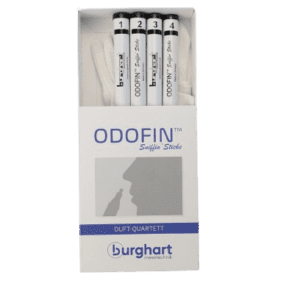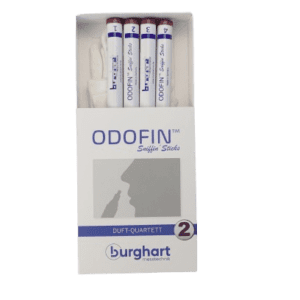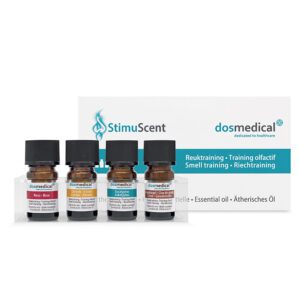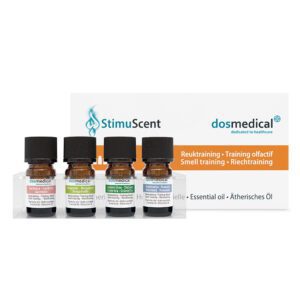What is smell training and is it effective? It may sound strange too train your nose, but it certainly makes sense. Training muscles by going to the gym or practicing a musical instrument every day ensures that you (hopefully) progress in what you practice. So you must also see smell training. It is, as it were, physiotherapy for the nose. That training your sense of smell is actually useful is evident from various studies and studies. On this page we will provide more background information about smell training and if it is suitable for you.
Smell training kits
Through our webshop you can order smell training kits with 4 Sniffin’ Sticks, and our smell training kit with 4 essential oils. Each set will be delivered in a box with a manual. We have these sets available from stock and can be shipped worldwide.
The smell training sets with essential oils and Sniffin’ Sticks consist of 4 different odors and are available in different combinations. The effect of all sets is the same, the biggest difference is the shelf life of the sets. The Sniffin’ Sticks have a longer shelf life than the sets with essential oils. With all of the sets you can perform smell training in accordance with the method prescribed by many (ENT) doctors worldwide.
What is smell training?
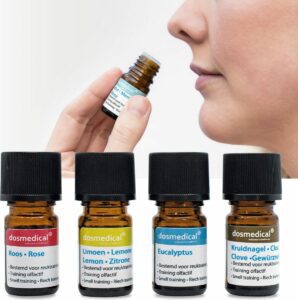
The basis of smell training is smelling at least 4 different odours twice a day. Our advice is to do this in the morning and in the evening. You should smell each odour for 10-20 seconds. If you start with smell training there is a good chance that you will not notice any smell in the beginning. However, it is important to focus on the little bit of smell you may smell and also try to visualize how the smell should smell so that the connection between your olfactory organ and brain is restored. Take a short break between the different scents so that your olfactory organ can really detect the difference between the scents. It is of course allowed to train more often and with different odours, the more your olfactory organ is stimulated the better! For an optimal effect, you should continue the training for several months, studies have shown that about 6 months of training gives the best effect.
Which odours for smell training?
The original 4 odours used for smell training are as follows:
- rose
- lemon
- clove
- eucalyptus
The above 4 odors are the original odors as chosen in the first scientific study about smell training. This study was led by Dr. Hummel (Technische Universität Dresden), the one who was the first to work on the concept of smell training. These odours were not chosen without reason. Just as tastes are classified into sweet, bitter, sour and salty, an attempt has also been made to classify odors. Over time, several olfactory training sets have come onto the market with additional scents, but also sets with multiple scents, this way you can vary and expand the training
We have the following smell training sets available
Smell training with ODOFIN Sniffin’ Sticks (Duft Quartett):
Set 1 with 4 Sniffin’ Sticks: Rose, Lime, Eucalyptus and Clove
Set 2 with 4 Sniffin’ Sticks: Mint, Jasmine, Thyme and Mandarin
Smell training with essential oils (Dos Medical):
Set 1 with 4 essential oils: Rose, Lime, Eucalyptus and Clove
Set 2 with 4 essential oils: Mint, Jasmine, Thyme and Mandarin
Set 3 with 4 essential oils: Green Tea, Rosemary, Bergamot and Gardenia
Is smell training suitable for me?
Losing or missing the sense of smell can have various causes which are know as olfactory disorders. Some people are born without a sense of smell and other people lose their sense of smell after a viral infection (such as corona), traumatic brain damage or a long-term cold. The effect of smell training has been investigated in various clinical studies and it appears that it mainly has an effect on people who have an smell disorder as a result of a virus infection, such as is the case with a corona infection, cold or flu.
In addition, research also indicates that smell training has a positive effect on restoring the sense of smell in traumatic brain injury. In traumatic brain injury, the effect depends on how severe the original injury was. In all cases, it is recommended to start the smell training as soon as possible after the loss of the sense of smell. Even in cases of anosmia and in post-viral patients who have no sense of smell, it may be useful to perform the smell training for stimulation, although it is known that with congenital anosmia the chance of recovery is very minimal.
Smell training is not a cure but a way to speed up and stimulate recovery. Think of it as a form of physiotherapy for the nose.
Practical tips for smell training
- It is important to smell the different scents twice a day. Preferably in the morning and evening.
Relax and breathe naturally. - Don’t smell overly loud or for too long. 10-20 seconds per scent is sufficient.
- Try to smell other things besides the 4 scents. For example herbs, flowers in the garden or perfumes. Anything that is safe to smell helps to stimulate the sense of smell.
- Hang in there and don’t quit. For some people the first effect is noticeable after a few weeks, in other cases it can take months. A positive effect is unfortunately not assured for everyone, but it is worth a try.
- It is advisable and interesting to keep a log of the smell training. Make notes of what you observe so that you can observe any progression. This does not have to be daily, but once a week or 2 weeks is more than enough. It is important that you have patience and do the training consistently. Unfortunately, the nerves that restore the olfactory system only slowly make patience and perseverance are important.
FAQ Smell training
How long should you train?
To notice the effect of the smell training, you must carry out the training for several months. Various studies have shown that for an optimal effect the training should be carried out for 6 months. It is also important that you do it every day. In the morning and in the evening. Keep the smell training kit in a handy place so that you don’t forget and you can train your sense of smell daily. Training more often and/or training with multiple scents is of course possible and can certainly be encouraged. The more you stimulate your sense of smell, the better it is for recovery.
How often per day should I train?
For an effective training, you should use the smell training kit 2 times a day. Preferably in the morning and in the evening. So put the smell training set in a handy place so that you don’t forget it! For example, think of the bedside table or in the kitchen.
Does it make sense for everyone?
Losing or missing the sense of smell can have various causes. Some people are born without a sense of smell and other people lose their sense of smell after a viral infection (such as corona), traumatic brain damage or a long-term cold. The effect of smell training has been investigated in various clinical studies and it appears that it mainly has an effect on people who have an smell disorder as a result of a virus infection, such as is the case with a corona infection, cold or flu.
In addition, research also indicates that scent training has a positive effect on restoring the sense of smell in traumatic brain injury. In traumatic brain injury, the effect depends on how severe the original injury was. In all cases, it is recommended to start the smell training as soon as possible after the loss of the sense of smell. Even in cases of anosmia and in post-viral patients who have no sense of smell, it may be useful to perform the smell training for stimulation, although it is known that with congenital anosmia the chance of recovery is very minimal.
Which smell disorders are there?
The following olfactory disorders can be distinguished:
- Anosmia: the total loss of the sense of smell. A distinction can be made between selective and complete anosmia. As the name suggests, selective anosmia is about not being able to smell certain odors. With complete anosmia, the person will no longer be able to perceive any odor.
- Hyposmia: a reduced sense of smell. This is a quantitative olfactory disorder and occurs in different grades: mild, moderate and severe. This form of sense of smell loss often occurs with aging and is not reversible.
- Parosmia: one this is a qualitative olfactory disorder in which odors are still observed but in which the smells are registered in a different way than usual. When registering the odors at parosmia, a distinction can be made between:
- Euosmia: smells are perceived as pleasant smells
- Troposmia: odors are perceived as dirty or unpleasant odors
- Hyperosmia: this is the case when a person perceives odors excessively. The smells are observed correctly but at a higher intensity.
- Agnosmia: odors are observed but the person is unable to name these odors.
How does smell training work?
Smell training stimulates the olfactory part of the brain. Clinical studies have shown that people who have performed the smell training have an improved sense of smell compared to people who have not performed smell training. The participants of the study had to perform an identification and an odor discrimination test. From this, the people who had trained their sense of smell came out of the test stronger. In this study, some of the participants performed the odor training with strong odors and some of the participants performed the training with less strong odors. This showed that the group with the strong odors had better results in the odor tests. This shows that the concentration (strength) of the odors is very important. With the help of a standardized smell training set you can be sure of the right concentration of smell. In addition, the smell training sets also have an expiration date so that you can be sure that the markers are still reliable and usable.
Can I get professional help?
Do you have an olfactory disorder and are you unsure what is going on? Then contact your doctor for further advice. There can be various causes for the loss of sense of smell and can have a major impact on your health. It is possible that your condition (such as anosmia) is not recognized by a doctor that causes frustration. It is therefore advisable to delve into odor loss before you visit your doctor or general practitioner.
What is the origin of smell training?
The most commonly used odor training is based on the research of Professor Thomas Hummel from the University of Dresden. This training consists of 2 times a day intensive smelling of 4 different scents: rose, eucalyptus, lemon (lime) and clove. This is the original fragrance training as prescribed by (ENT) doctors worldwide. This training can be performed with the help of 4 fragrance pens or with 4 oils.
Dr. Hummel method
These pens are in collaboration with Dr. Hummel developed by the company Burghart and available through our webshop. The advantage of these pens is that they last for a long time (about 1-1.5 years) and are easy to use. They are, as it were, four felt-tip pens that are not provided with ink but with natural fragrances. Each pen has a best-before date so you can be sure that the pens have the correct fragrance strength and are reliable for the training. As an alternative to the fragrance pens, you can also use essential oils, for example.
Odor prism
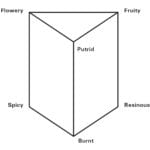
The by Dr. Hummel selected scents for the 4 sticks are based on these scents:
- Flowers: rose
- Fruity: lemon
- Spicy: clove
- Resinous: eucalyptus
Can I train my sense of taste?
Unfortunately, there are no sets available for training the sense of taste. Alteration of taste often occurs in combination with loss of smell. This may involve the following changes:
- Loss of taste (you no longer taste the basic flavors: sweet, salty, sour, bitter, umami), also known as ageusie.
- Taste distortions (flavors are perceived differently, often foul), also called parageusia.
Loss of taste is less common than loss of smell. Can you still taste the basic flavors of salty, sweet, hour, bitter and umami on your tongue? Then you are most likely dealing with a loss of smell and not a loss of taste. Loss of taste is probably caused by the virus being present in the saliva, which affects the taste transfer. Exactly how this works is not (yet) entirely clear.
We do supply taste tests for testing taste.
How do I get my sense of smell and taste back?
Depending on how you lost your sense of smell and taste, we recommend smell training to stimulate recovery. Smell training consists of intensively smelling 4 different scents twice a day. You should maintain this for a longer period of time, preferably 6 months. You can do this with the help of our smell training sets. Read more about smell training at the top of this page.
How long will it take to get my sense of smell back?
This differs per case. In some people, the sense of smell returns after 2 to 4 weeks, but in some people this can also take much longer. In about 50% of all cases, the sense of smell will fully recover during this time. After eight weeks, 76% of infected people have fully recovered. “Bad” 4% experienced no improvement after eight weeks.
At the moment there are many studies worldwide in the field of odor loss, in which researchers are busy every day with the question of what exactly happens as soon as a patient becomes infected with a (corona) virus.
Loss of taste
Loss of taste is often the result of a loss of smell. Many people can still experience flavors with the tongue, but no longer get the smells through the nose. As a result, the taste is no longer properly linked to the smell and that results in a different experience of tasting the food.
Can I order the smell training kits as a private customer?
Yes, you can. You can also order the smell training sets as a private individual via our webshop. Please note that the prices are exclusive of VAT. We have the sets available from stock and we ship them worldwide.
Do you also have smell tests?
Yes, we alsu supply smell tests. Smell tests are validated tests that are mainly used by (ENT) doctors and researchers and are used worldwide.
What do the scientists say?
Smell training stimulates the olfactory part of the brain. Clinical studies have shown that people who have performed the smell training have an improved sense of smell compared to people who have not performed smell training. The participants of the study had to perform an identification and a discrimination odor test. From this, the people who had trained their sense of smell came out of the test stronger. In this study, some of the participants performed the odor training with strong odors and some of the participants performed the training with less strong odors. This showed that the group with the strong odors had better results in the odor tests. This shows that the concentration (strength) of the odors is very important. Below are some links to scientific publications:
Publications
Does is matter which odours I use for training?
Many of the studies have used the same four odours: lemon, rose, clove, and eucalyptus. However, there is no evidence to say that these are the only ‘correct’ odours to use, so feel free to add other scents as well. In any case, it’s a good idea to choose scents that you recognize and remember. Try to stimulate your sense of smell as much as possible, even at times when you are not engaged in olfactory training. Think, for example, of a walk through the park where you can smell flowers or smell an orange while eating. All this will help you boost the sense of smell and recovery.modified olfactory training in patienst with postinfectious olfactory loss
My smell is gone, do I have corona?
That is certainly possible, but of course we cannot say for sure. While COVID-19 has become indispensable, it is now more than clear that the loss of smell and taste is a symptom of infection with the COVID-19 virus. Post-viral anosmia is known to be one of the leading causes of loss of sense of smell in adults, accounting for up to 40% of anosmia cases. More and more facts are emerging that indicate that a sudden loss of smell can indicate a corona infection. In addition, it can be a clear indication that someone is a ‘hidden carrier’, even if they have no other symptoms. On this page more information about smell loss in relation to COVID-19.

